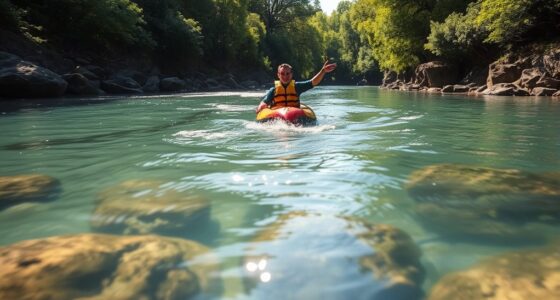To keep children safe around water, always use approved flotation devices that fit snugly and support their torso without restricting movement. Keep a close, constant eye on them, never leaving them unattended, even in shallow water. Regularly check that their flotation gear is in good condition and properly secured. Enroll them in swimming lessons, use barriers, and reinforce safety rules. Following these guidelines helps guarantee their safety, and there’s more to discover about effective water safety practices next.
Key Takeaways
- Always supervise children closely around water, regardless of flotation device use.
- Ensure water vests fit properly, are in good condition, and are correctly secured before water entry.
- Use age-appropriate, safety-approved flotation devices designed for children’s specific water activities.
- Enroll children in swimming lessons and establish safety barriers to reinforce water safety.
- Regularly inspect and maintain flotation devices, and combine their use with vigilant supervision and safety measures.

Ensuring children’s safety around water is essential, and understanding floating safety is a vital part of that. One of the most effective ways to do this is by using appropriate flotation devices, such as a water vest. A water vest provides buoyancy, helping children stay afloat if they accidentally fall into the water. When selecting flotation devices, opt for those specifically designed for children, making sure they fit properly and are approved by safety standards. A well-fitting water vest snugly supports the child’s torso without restricting movement, giving both the child and parent peace of mind.
Use properly fitted, safety-approved water vests to keep children buoyant and secure around water.
It’s crucial to remember that flotation devices, including water vests, are not substitutes for active supervision. No matter how reliable a flotation device may seem, constant adult supervision is irreplaceable. Children can panic or dislodge their flotation device in unpredictable circumstances, so never leave them unattended near water. Always double-check that the flotation device is in good condition, free from tears or damage, and that it’s secured correctly before allowing a child to enter the water. Properly fitting flotation devices are essential because an ill-fitting vest can slip off or fail to provide adequate buoyancy.
Understanding how flotation devices work helps you make informed safety choices. For instance, some devices are designed for specific water activities—swimming, boating, or water play—so select the right type for your child’s activity. Using a water vest can greatly reduce the risk of drowning, but it’s just one part of a comprehensive safety plan. Enrolling your child in swimming lessons can teach them vital skills and increase their confidence in water, complementing the safety offered by flotation devices.
Additionally, choosing firearm-friendly payment processors that prioritize security and compliance can help ensure your transactions remain protected when dealing with water safety products or related services.
Always make sure children wear their flotation devices whenever they’re in or around water, including shallow pools, lakes, or even bathtubs. Remember that water vests are most effective when properly fitted and used as part of a layered safety approach that includes vigilant supervision, swimming lessons, and secure barriers around water sources. Never assume a child is safe just because they’re wearing a flotation device; children can sometimes slip out of them or misuse them. Regularly review safety guidelines with kids so they understand they shouldn’t rely solely on devices but must also follow rules and stay attentive.
Frequently Asked Questions
At What Age Should Children Start Swimming Lessons?
You should start swimming lessons for your child around age four, aligning with their developmental milestones like improved coordination and independence. Early lessons help build water comfort and safety skills. Remember, parent supervision strategies are crucial—always watch your child closely, regardless of their age or swimming ability. Introducing swimming early fosters confidence and safety skills, but ongoing supervision is essential for preventing accidents and ensuring a positive experience in the water.
How Often Should Floatation Devices Be Inspected?
You should inspect flotation devices regularly, ideally before each use, to guarantee life jacket maintenance and floatation device durability. Check for signs of wear, tears, or deterioration in straps, buckles, and fabric. Replace or repair any damaged equipment immediately to keep your child safe. Frequent inspections help maintain the device’s effectiveness, preventing accidents caused by compromised floatation devices. Stay vigilant and prioritize ongoing checks for maximum safety.
Are There Specific Brands Recommended for Children’s Life Jackets?
Choosing children’s flotation devices is like finding a trusty shield—trustworthy brands matter. You should look for well-known, reputable life jacket brands that meet safety standards. Brands like Stearns, Onyx, and Stohlquist are reliable options. Always check for proper fit and certification labels. These trusted life jacket brands guarantee your child’s safety and comfort, giving you peace of mind when they’re in or near water.
What Are Signs of Water Anxiety in Children?
You might notice signs of water anxiety in children, like reluctance to enter the pool or crying when near water. They could show water phobia, avoiding splashes or refusing to float, and may resist swimming activities due to swimming resistance or fear of sinking. Watch for these behaviors, and gently encourage positive experiences. Patience and reassurance help children build confidence and overcome water anxiety safely.
How Can Parents Teach Water Safety Beyond Floating?
Think of water safety education as planting seeds for your child’s confidence. You should teach them about safe swimming practices, never swimming alone, and recognizing dangers. Practice emergency response training together, like how to call for help or perform basic rescue skills. By actively involving your child in these lessons, you help them become aware of risks and prepare them to stay safe, making every splash a safe adventure.
Conclusion
Remember, your child’s safety in and around water is your top priority. Always supervise, use proper floatation devices, and stay alert. Think of it as guarding the Ark—protecting your little ones from unexpected storms. Even with the best precautions, accidents can happen. So, stay vigilant, be prepared, and cherish every splash and smile. After all, a safe child is a happy child—because in the end, safety isn’t just a modern concern; it’s timeless wisdom.










